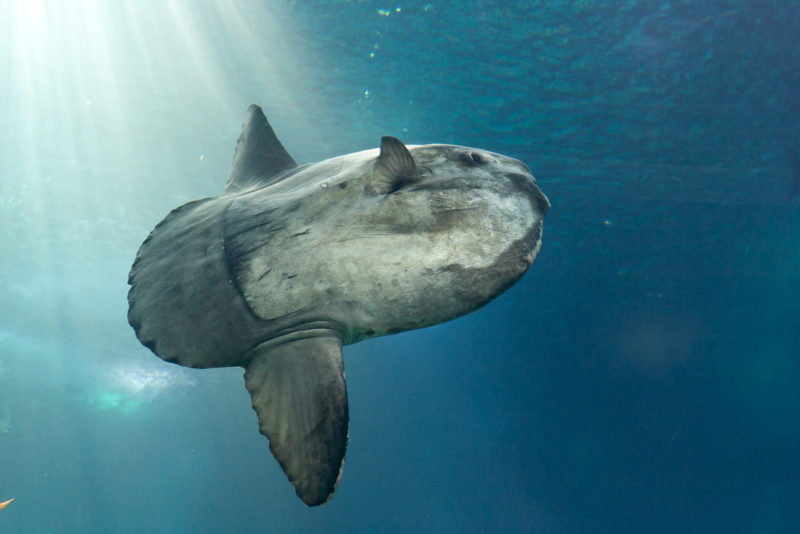Most sci-fi space movies feature at least one spaceship that looks just wrong: awkward, aerodynamically unsound, ugly. The ship of “Star Wars” bounty hunter Jango Fett, for example, resembles a disembodied aardvark head. Who would deliberately design a spaceship like that? The indisputable underwater equivalent is the mola mola, whose bizarre appearance earns it a spot on the must-see list of many divers.
 What is a mola mola?
What is a mola mola?
Imagine a thick, 10-foot (3 m) long oval serving platter with two wide, blade-shaped handles positioned at one end, well off-center. Balance the platter vertically on a long edge, add two anime eyes and a round, gaping mouth and you’ve got a mola mola.
Its ungainly otherworldliness doesn’t end with physiology. Lacking a caudal fin to propel itself through the water, it swims by rather weakly waving its bladelike dorsal and ventral fins and wiggling the part of its body where the tail should be. Aesthetically, the creature appears broken, like some critical anatomical feature is missing.
In non-English languages, the common names for the mola mola reflect its appearance: “moon fish,” “swimming head,” “head alone,” and best of all, the “toppled wheel fish.” Its English-language common name is more boring: oceanic sunfish, so named because of its habit of sunning itself at the surface after a deep food-hunting dive.
The oceanic sunfish is the heaviest bony fish in the world. “Mola” is Latin for millstone, with mature adults weighing 2,200 pounds (1000 kg) or more. Such size requires a lot of food. Because its diet consists primarily of jellyfish, which are nutritionally poor, it must eat almost constantly. It uses its beaklike teeth to gnaw at its prey, sucking it down its throat.
The mola also provides meals to other species. More than 40 different kinds of parasites live on or in the sunfish. Cleaner wrasses and reef fish feast on the parasites, as do seagulls, which pick at the mola’s rough skin when it’s sunning itself at the surface.
Where can you find them?
Because the mola mola spends most of its time deep and in the open ocean, divers seeking an encounter must visit a reef-side cleaning station. Popular spots include Punta Vincente Roca in the Galapagos Islands; Nusa Penida, Indonesia (off the east coast of Bali); and a few spots in the northern Mediterranean. That said, since its habitat includes temperate and tropical waters around the world, divers have seen them in dozens of spots.
As have fishermen. A few years ago, two Boston locals sunning itself in Boston Harbor. They had no idea what it was. Hilarity ensued. They filmed their encounter, and the viral video, which includes a comically heavy dose of swearing, perfectly captures the irresistible eccentricity of the mola mola.
Guest author Christina Koukkos is a New York-based freelance writer and editor. She covers scuba diving, responsible tourism, off-beat destinations, cultural travel and other topics. She’s a certified PADI dive instructor and MSDT as well as an amateur underwater (and topside) photographer. Learn more about her on her website, her blog, on Instagram or Twitter.

